Research Area D - Publications 2014
29-Dec-2014

Quantitative proteome research is greatly promoted by high-resolution parallel format assays. A characterization of protein complexes based on binding forces offers an unparalleled dynamic range and allows for the effective discrimination of non-specific interactions. Here we present a DNA-based Molecular Force Assay to quantify protein-protein interactions, ...
04-Dec-2014
FEMS Microbiology Letters, online article

In Escherichia coli, detoxification of methylglyoxal (MG) requires glyoxalases I and II. Glyoxalase I (gloA/GlxI) isomerizes the hemithioacetal, formed spontaneously from MG and glutathione (GSH) to S-lactoylglutathione (SLG), which is hydrolyzed by glyoxalase II (gloB/GlxII) to lactate and GSH. YcbL from Salmonella enterica serovar Typhimurium is an unusual type ...
01-Dec-2014
Genes & Development, online article
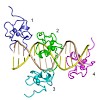
The male-specific lethal dosage compensation complex (MSL-DCC) selectively assembles on the X chromosome in Drosophila males and activates gene transcription by twofold through histone acetylation. An MSL recognition element (MRE) sequence motif nucleates the initial MSL association, but how it is recognized remains unknown. Here, we identified the CXC domain of ...
17-Nov-2014
JBC, online article
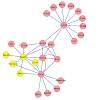
In vitro, assembly of box C/D small nucleolar ribonucleoproteins (snoRNPs) involves the sequential recruitment of core proteins to snoRNAs. In vivo, however, assembly factors are required (NUFIP, BCD1, and the HSP90–R2TP complex), and it is unknown whether a similar sequential scheme applies. In this paper, we describe systematic quantitative stable isotope ...
12-Nov-2014
Nature Communication, online article
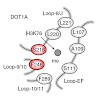
DOT1 enzymes are conserved methyltransferases that catalyse the methylation of lysine 79 on histone H3 (H3K79). Most eukaryotes contain one DOT1 enzyme, whereas African trypanosomes have two homologues, DOT1A and DOT1B, with different enzymatic activities. DOT1A mediates mono- and dimethylation of H3K76, the homologue of H3K79 in other organisms, whereas ...
06-Nov-2014
Cell Reports, online article
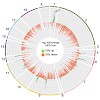
An astounding property of the nervous system is its cellular diversity. This diversity, which was initially realized by morphological and electrophysiological differences, is ultimately produced by variations in gene-expression programs. In most cases, these variations are determined by external cues. However, a growing number of neuronal types have been ...
05-Nov-2014
Nature Structural & Molecular Biology, online article
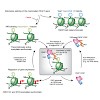
The human histone macroH2A.1.1 recruits activated PARP1 enzyme to chromatin through its poly(ADP-ribose)-binding macrodomain. New work shows that PARP1 and CBP can be displaced from chromatin in cancer cells that have lost macroH2A.1.1, thus leading to changes in histone H2B acetylation at cancer-relevant genes.
16-Oct-2014
The Embo Journal, online article
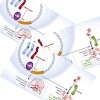
Aneuploidy is a hallmark of cancer and is associated with malignancy and poor prognosis. Recent studies have revealed that aneuploidy inhibits proliferation, causes distinct alterations in the transcriptome and proteome and disturbs cellular proteostasis. However, the molecular mechanisms underlying the changes in gene expression and the impairment of ...
09-Oct-2014
Cell Reports, online artticle
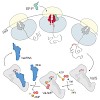
Bacterial ribosomes stall on polyproline stretches and require the elongation factor P (EF-P) to relieve the arrest. Yet it remains unclear why evolution has favored the development of EF-P rather than selecting against the occurrence of polyproline stretches in proteins. We have discovered that only a single polyproline stretch is invariant across all domains of ...
26-Sep-2014
FEMS Microbiology Reviews, 2014, DOI: 10.1111/1574-6976.12083, Volume 38, Issue 6, pages 1172–1201, published on 26.09.2014
FEMS Microbiology Review, online article
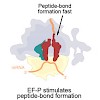
Throughout their life, bacteria need to sense and respond to environmental stress. Thus, such stress responses can require dramatic cellular reprogramming, both at the transcriptional as well as the translational level. This review focuses on the protein factors that interact with the bacterial translational apparatus to respond to and cope with different types ...
27-Aug-2014
Nature Communications, online article
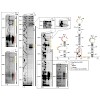
Dosage compensation is a regulatory process that balances the expression of X-chromosomal genes between males (XY) and females (XX). In Drosophila, this requires non-coding RNAs and RNA-binding proteins (RBPs) whose specific functions remain elusive. Here we show that the Drosophila RBP UNR promotes the targeting of the activating male-specific-lethal complex to ...
20-Aug-2014
Nucleic Acids Research, online article

The polymerization of amino acids into proteins occurs on ribosomes, with the rate influenced by the amino acids being polymerized. The imino acid proline is a poor donor and acceptor for peptide-bond formation, such that translational stalling occurs when three or more consecutive prolines (PPP) are encountered by the ribosome. In bacteria, stalling at PPP ...
18-Aug-2014
Molecular Systems Biology, online article
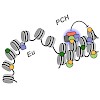
The cell establishes heritable patterns of active and silenced chromatin via interacting factors that set, remove, and read epigenetic marks. To understand how the underlying networks operate, we have dissected transcriptional silencing in pericentric heterochromatin (PCH) of mouse fibroblasts. We assembled a quantitative map for the abundance and interactions of ...
07-Aug-2014
Molecular Cell, online article
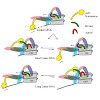
ISWI family chromatin remodeling enzymes generate regularly spaced nucleosome arrays. In a recent Nature report, Hwang et al. (2014) describe how ACF gauges the length of linker DNA when deciding to accelerate nucleosome sliding or to put on the brakes.
04-Aug-2014
PLoS ONE, online article
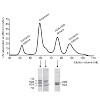
The development of methods to assemble nucleosomes from recombinant histones decades ago has transformed chromatin research. Nevertheless, nucleosome reconstitution remains time consuming to this day, not least because the four individual histones must be purified first. Here, we present a streamlined purification protocol of recombinant histones from bacteria. ...
03-Aug-2014
Epigenetics & Chromatin, online article
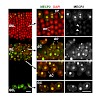
Methyl-CpG binding protein 2 (MECP2) is a protein that specifically binds methylated DNA, thus regulating transcription and chromatin organization. Mutations in the gene have been identified as the principal cause of Rett syndrome, a severe neurological disorder. Although the role of MECP2 has been extensively studied in nervous tissues, still very little is ...
24-Jul-2014
Cell Reports, online article

Although selective binding of 53BP1 to dimethylated histone H4 lysine 20 (H4K20me2) at DNA double-strand breaks (DSBs) is a necessary and pivotal determinant of nonhomologous end joining (NHEJ)-directed repair, the enzymes that generate H4K20me2 at DSBs were unclear. Here, we determined that the PR-Set7 monomethyltransferase (H4K20me1) regulates de novo H4K20 ...
14-Jul-2014
PROTEOMICS, online article
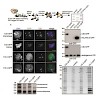
Centromeres are chromosomal regions crucial for correct chromosome segregation during mitosis and meiosis. They are epigenetically defined by centromeric proteins such as the centromere-specific histone H3-variant centromere protein A (CENP-A). In humans, 16 additional proteins have been described to be constitutively associated with centromeres throughout the ...
A Modular View of the Diversity of Cell-Density-Encoding Schemes in Bacterial Quorum-Sensing Systems
01-Jul-2014
Biophysical Journal, 2014, http://dx.doi.org/10.1016/j.bpj.2014.05.031, Volume 107, Issue 1, 266–277, published on 01.07.2014
Biophysical Journal, online article
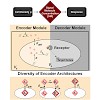
Certain environmental parameters are accessible to cells only indirectly and require an encoding step for cells to retrieve the relevant information. A prominent example is the phenomenon of quorum sensing by microorganisms, where information about cell density is encoded by means of secreted signaling molecules. The mapping of cell density to signal molecule ...
19-Jun-2014
Nucleic Acids Research, online article
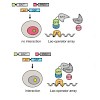
The discovery of hydroxymethyl-, formyl- and carboxylcytosine, generated through oxidation of methylcytosine by TET dioxygenases, raised the question how these modifications contribute to epigenetic regulation. As they are subjected to complex regulation in vivo, we dissected links to gene expression with in vitro modified reporter constructs. We used an Oct4 ...
22-May-2014
Molecular Cell., online article
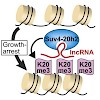
A complex network of regulatory pathways links transcription to cell growth and proliferation. Here we show that cellular quiescence alters chromatin structure by promoting trimethylation of histone H4 at lysine 20 (H4K20me3). In contrast to pericentric or telomeric regions, recruitment of the H4K20 methyltransferase Suv4-20h2 to rRNA genes and IAP elements ...
18-May-2014

Ten eleven translocation (Tet) enzymes oxidize the epigenetically important DNA base 5-methylcytosine (mC) stepwise to 5-hydroxymethylcytosine (hmC), 5-formylcytosine and 5-carboxycytosine. It is currently unknown whether Tet-induced oxidation is limited to cytosine-derived nucleobases or whether other nucleobases are oxidized as well. We synthesized isotopologs ...
09-May-2014
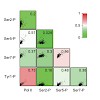
In mammals, the carboxy-terminal domain (CTD) of RNA polymerase (Pol) II consists of 52 conserved heptapeptide repeats containing the consensus sequence Tyr1-Ser2-Pro3-Thr4-Ser5-Pro6-Ser7. Post-translational modifications of the CTD coordinate the transcription cycle and various steps of mRNA maturation. Here we describe Tyr1 phosphorylation (Tyr1P) as a hallmark ...
29-Apr-2014
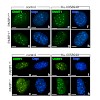
Poly(ADP-ribose) polymerase 1 (PARP1, also known as ARTD1) is an abundant nuclear enzyme that plays important roles in DNA repair, gene transcription and differentiation through the modulation of chromatin structure and function. In this work we identify a physical and functional poly(ADP-ribose) mediated interaction of PARP1 with the E3 ubiquitin ligase UHRF1 ...
28-Apr-2014

Double-stranded DNA (dsDNA) in the cytoplasm triggers the production of interleukin 1β (IL-1β) as an antiviral host response, and deregulation of the pathways involved can promote inflammatory disease. Here we report a direct cytosolic interaction between the DNA-damage sensor Rad50 and the innate immune system adaptor CARD9. Transfection of dendritic cells with ...
24-Apr-2014
Cell Reports, online article
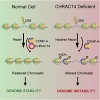
Chromatin reorganization and the incorporation of specific histone modifications during DNA damage response are essential steps for the successful repair of any DNA lesion. Here, we show that the histone-fold protein CHRAC14 plays an essential role in response to DNA damage in Drosophila. Chrac14 mutants are hypersensitive to genotoxic stress and do not activate ...
20-Apr-2014
Nucl. Acids Res., online article
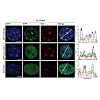
Histone variants play an important role in shaping the mammalian epigenome and their aberrant expression is frequently observed in several types of cancer. However, the mechanisms that mediate their function and the composition of the variant-containing chromatin are still largely unknown. A proteomic interrogation of chromatin containing the different H2A ...
24-Mar-2014
Nature Communications, online article
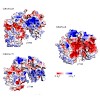
Phosphorylation of the RNA polymerase II C-terminal domain (CTD) by cyclin-dependent kinases is important for productive transcription. Here we determine the crystal structure of Cdk12/CycK and analyse its requirements for substrate recognition. Active Cdk12/CycK is arranged in an open conformation similar to that of Cdk9/CycT but different from those of cell ...
21-Mar-2014
Journal of Bacteriology, online article
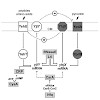
When carbon sources become limiting for growth, bacteria must choose which of the remaining nutrients should be used first. We have identified a nutrient-sensing signaling network in Escherichia coli that is activated at the transition to stationary phase. The network is composed of the two histidine kinase/response regulator systems YehU/YehT and YpdA/YpdB and ...
12-Mar-2014
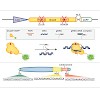
Labeling and tracing of specific sequences in living cells has been a major challenge in studying the spatiotemporal dynamics of native chromatin. Here we repurposed the prokaryotic CRISPR/Cas adaptive immunity system to specifically detect endogenous genomic loci in mouse embryonic stem cells. We constructed a catalytically inactive version of the Cas9 ...
26-Feb-2014
PLOS, online article
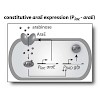
Inducible switching between phenotypes is a common strategy of bacteria to adapt to fluctuating environments. Here, we analyze the switching kinetics of a paradigmatic inducible system, the arabinose utilization system in E. coli. Using time-lapse fluorescence microscopy of microcolonies in a microfluidic chamber, which permits sudden up- and down-shifts in the ...
18-Feb-2014
BMC Genomics, online article
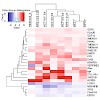
Aneuploidy, a karyotype deviating from multiples of a haploid chromosome set, affects the physiology of eukaryotes. In humans, aneuploidy is linked to pathological defects such as developmental abnormalities, mental retardation or cancer, but the underlying mechanisms remain elusive. There are many different types and origins of aneuploidy, but whether there is a ...
14-Feb-2014
Biochimica et Biophysica Acta (BBA), online article
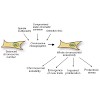
Despite its ubiquity in cancer, link with other pathologies, and role in promoting adaptive evolution, the effects of aneuploidy or imbalanced chromosomal content on cellular physiology have remained incompletely characterized. Significantly, it appears that the detrimental as well as beneficial effects of aneuploidy are due to the altered gene expression ...
14-Feb-2014
Cell Research, online article
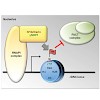
Chemical modifications of histone proteins directly and indirectly affect chromatin structure and thereby contribute to the multilayered control of diverse DNA-based processes. A recent study in Nature enriches this list of enzyme-dependent posttranslational histone marks by H2A glutamine methylation that appears to be dedicated to only one specific cellular ...
12-Feb-2014
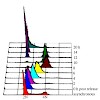
The functional identity of centromeres arises from a set of specific nucleoprotein particle subunits of the centromeric chromatin fibre. These include CENP-A and histone H3 nucleosomes and a novel nucleosome-like complex of CENPs -T, -W, -S and -X. Fluorescence cross-correlation spectroscopy and Förster resonance energy transfer (FRET) revealed that human CENP-S ...
06-Feb-2014
PLOS ONE, 2014, DOI: 10.1371/journal.pone.0088411, published on 06.02.2014
PLOS ONE, online article
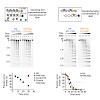
ISWI is the catalytic subunit of several ATP-dependent chromatin remodelling factors that catalyse the sliding of nucleosomes along DNA and thereby endow chromatin with structural flexibility. Full activity of ISWI requires residues of a basic patch of amino acids in the N-terminal ‘tail’ of histone H4. Previous studies employing oligopeptides and mononucleosomes ...
16-Jan-2014
European Journal of Immunology, online article
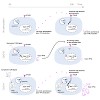
Plasmacytoid dendritic cells (pDCs) are responsible for the robust and immediate production of type I IFNs during viral infection. pDCs employ TLR7 and TLR9 to detect RNA and CpG motifs present in microbial genomes. CpG-A was the first synthetic stimulus available that induced large amounts of IFN-α (type I IFN) in pDCs. CpG-B, however, only weakly activates pDCs ...
14-Jan-2014
The Journal of Biological Chemistry, online article
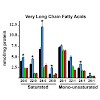
The circadian clock regulates a wide range of physiological and metabolic processes, and its disruption leads to metabolic disorders such as diabetes and obesity. Accumulating evidence reveals that the circadian clock regulates levels of metabolites that, in turn, may regulate the clock. Here we demonstrate that the circadian clock regulates the intracellular ...
09-Jan-2014
Journal of Molecular Biology, online article
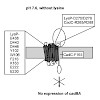
The coordination of signal transduction and substrate transport represents a sophisticated way to integrate information on metabolite fluxes into transcriptional regulation. This widely distributed process involves protein-protein interactions between two integral membrane proteins. Here we report new insights into the molecular mechanism of the regulatory ...










